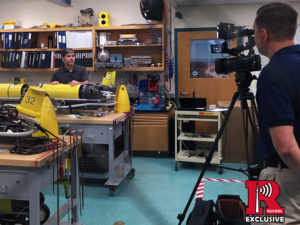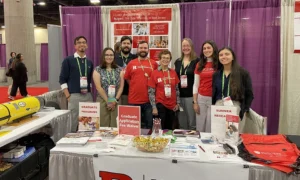Grace Saba, assistant professor in the Department of Marine and Coastal Sciences (DMCS), is the lead principal investigator and John Wilkin, professor in DMCS, is co-principal investigator of $1,499,895 million project observing ocean acidification on the U.S. Northeast Shelf, from the Mid-Atlantic to the Gulf of Maine.
The project, “Optimizing Ocean Acidification Observations for Model Parameterization in the Coupled Slope Water System of the U.S. Northeast Large Marine Ecosystem,” is funded by the NOAA’s Ocean Acidification Program (OAP), which has teamed up with the U.S. Integrated Ocean Observing System (IOOS®) to fund a total of four projects aimed at improving the observing system design for characterizing ocean acidification.
The U.S. Northeast Shelf Large Marine Ecosystem supports some of the nation’s most economically valuable coastal fisheries, and most of this revenue comes from shellfish that are sensitive to ocean acidification.
Additional co-PIs on the Rutgers-led project include Charles Flagg and Janet Nye, Stony Brook University; Joe Salisbury and Doug Vandemark, University of New Hampshire; Neal Pettigrew, University of Maine; Gerhard Kuska, Mid-Atlantic Regional Association Coastal Ocean Observing System; and John R. Morrison, Northeastern Regional Association of Coastal Ocean Observing Systems. The three-year project runs from September 2019 to August 2022.
There are hundreds, if not thousands, of eyes on our changing ocean at any moment: Buoys, gliders, saildrones and ships measure carbonate chemistry and new ocean observing technologies are continually being created to monitor ocean acidification. As science and technology progress it is important to ensure that the most up-to-date knowledge is applied to the task at hand.
This work will evaluate the capability of existing observations to characterize the magnitude and extent of acidification and explore alternative regional ocean acidification observing approaches. Ultimately this work will minimize errors in measurements, better integrate existing observations, and minimize costs of monitoring ocean acidification.
The research team, led by Saba, plans to add seasonal deployments of underwater gliders equipped with sensors, including newly developed pH sensors, to understand how the ocean chemistry in this region varies on seasonal timescales relevant to organism ecologies and life histories. They also plan to improve existing regional sampling with additional carbonate chemistry measurements on other platforms in several key locations, and compiling and integrating this new information with existing OA assets.
The researchers will then apply these data to an existing ocean ecosystem/biogeochemical (BGC) model to explore how carbonate chemistry is changing on the Northeast Shelf. The model will then be used to test hypotheses focused on what drives ocean acidification and identify locations for long term monitoring.




